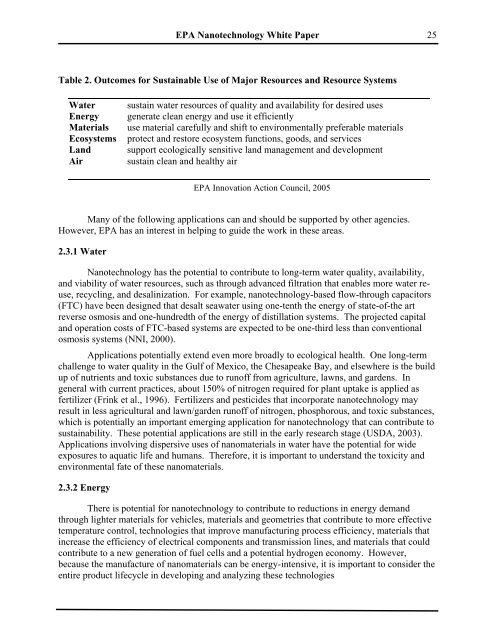Nanotechnology White Paper - US Environmental Protection Agency
Nanotechnology White Paper - US Environmental Protection Agency
Nanotechnology White Paper - US Environmental Protection Agency
You also want an ePaper? Increase the reach of your titles
YUMPU automatically turns print PDFs into web optimized ePapers that Google loves.
EPA <strong>Nanotechnology</strong> <strong>White</strong> <strong>Paper</strong><br />
25<br />
Table 2. Outcomes for Sustainable Use of Major Resources and Resource Systems<br />
Water<br />
Energy<br />
Materials<br />
Ecosystems<br />
Land<br />
Air<br />
sustain water resources of quality and availability for desired uses<br />
generate clean energy and use it efficiently<br />
use material carefully and shift to environmentally preferable materials<br />
protect and restore ecosystem functions, goods, and services<br />
support ecologically sensitive land management and development<br />
sustain clean and healthy air<br />
EPA Innovation Action Council, 2005<br />
Many of the following applications can and should be supported by other agencies.<br />
However, EPA has an interest in helping to guide the work in these areas.<br />
2.3.1 Water<br />
<strong>Nanotechnology</strong> has the potential to contribute to long-term water quality, availability,<br />
and viability of water resources, such as through advanced filtration that enables more water reuse,<br />
recycling, and desalinization. For example, nanotechnology-based flow-through capacitors<br />
(FTC) have been designed that desalt seawater using one-tenth the energy of state-of-the art<br />
reverse osmosis and one-hundredth of the energy of distillation systems. The projected capital<br />
and operation costs of FTC-based systems are expected to be one-third less than conventional<br />
osmosis systems (NNI, 2000).<br />
Applications potentially extend even more broadly to ecological health. One long-term<br />
challenge to water quality in the Gulf of Mexico, the Chesapeake Bay, and elsewhere is the build<br />
up of nutrients and toxic substances due to runoff from agriculture, lawns, and gardens. In<br />
general with current practices, about 150% of nitrogen required for plant uptake is applied as<br />
fertilizer (Frink et al., 1996). Fertilizers and pesticides that incorporate nanotechnology may<br />
result in less agricultural and lawn/garden runoff of nitrogen, phosphorous, and toxic substances,<br />
which is potentially an important emerging application for nanotechnology that can contribute to<br />
sustainability. These potential applications are still in the early research stage (<strong>US</strong>DA, 2003).<br />
Applications involving dispersive uses of nanomaterials in water have the potential for wide<br />
exposures to aquatic life and humans. Therefore, it is important to understand the toxicity and<br />
environmental fate of these nanomaterials.<br />
2.3.2 Energy<br />
There is potential for nanotechnology to contribute to reductions in energy demand<br />
through lighter materials for vehicles, materials and geometries that contribute to more effective<br />
temperature control, technologies that improve manufacturing process efficiency, materials that<br />
increase the efficiency of electrical components and transmission lines, and materials that could<br />
contribute to a new generation of fuel cells and a potential hydrogen economy. However,<br />
because the manufacture of nanomaterials can be energy-intensive, it is important to consider the<br />
entire product lifecycle in developing and analyzing these technologies
















